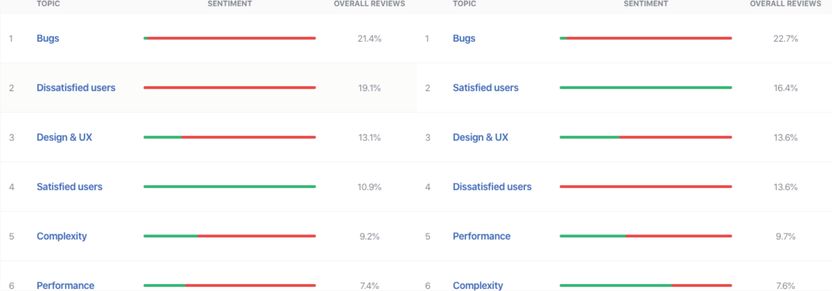Mobile first has been proven as a successful strategy in some markets while the rests are catching up, how do we fast forward H&M's app experience while maintaining the core business idea and its ongoing operation?
What went wrong?
Back in 2019, H&M was still in the process of transformation, including turning project-steered approach to empowered product organization. This seems straight-forward question led to long lasting discussion, involving project steering group, program steering group and our appointed product team - "App Experience". At this stage, the limited number of product teams at H&M are not yet autonomous.
To navigate between all the discussions from various directions, swift, honest yet concrete proposal from our product team is crucial. Together with product owner, we set up 3 tracks to understand how we can solve this challenge:
- Digest steering groups' wishes and the deadline of achieving improvement they set
- Gather insights on customers' perception of our app experience quantitative
- Collect qualitative customer feedback on using our app
The goal of our analysis work aims at turning project feature based achievement into scalable long-term success metrics, yet making sure our product team can realize the plan within the timeframe set by the steering groups.
The quantitative and qualitative sources include but not limited to:
- appbot's live analytics of app stores reviews and ratings
- Google Analytics's aggregated usage data
- App Annie's global trend report
- Ongoing user studies carried out by fellow design team members of their work that covers mobile application
- Other internal initiatives aim at modernising H&M's digital store experience
What's the plan?
Continuous alignment with the steering groups is very important throughout, while taking rapid decisions within the product team based on the discussions with the stakeholders.
Analysis of the app stores' reviews and ongoing user studies, it is clear that the foundations of app setup needs overhaul due to previous legacy development processes, both to improve customers' perceived app spped and stability and also to provide a solid groundwork to be able to scale going forward. This is inline with one of the goals of steering groups' target, but outlined in concrete actionable tasks for our product team, also enabling the initiative to modernise our digital store experience.
A proposal of 3 stages towards a customer loved app is put forward to the steering groups and stakeholders.
1. Regain trust 🏚
Our app ratings (the ratings with reviews attached) are much lower than same industry average. These reviews complaint about bugs (in terms of the app did not respond in what users expect), bad usability (of legacy project based development), complexity and performance. These complaints are strengthened by the highly diversed app use cases reflected through usage data and user studies, such as when being used in our store in a shopping mall where internet connection is not stable.
Moreover, our app is being used frequently of fragmented moments like during part of commuting. With the global trend of social and entertainment apps taking larger footprint of people's attention, we have the understand that we are not only competing with "traditional" competitors within the same industry, but also the larger landscape. This results in conclusion to regain users' trust through fixing the basics.
Actionable tasks are categorized into 3 S - speed, stability and scalability. Outdated codebase within the core shopping flow needs to be refactored; fragmented features needs to be re-designed to fit where users expect them to be; slim down app codebase removing many retired features; app specific design and development guidelines such as error handling; and many more.
Key success metrics:
- (Un)installation rate
- (Dis)satisfaction rate
- Retention rate
2. Develop relationship 🏡
Above stage sets a timeframe of half a year, inline with the scope of the steering group. But improving app experience could not and should not stop just after that. With a solid and scalable app foundation, what are the possibilities beyond that? To be noted that, what we want to achieve at stage 2 is highly dependent on the concrete actions being taken during stage 1 that also serves as a strong argument of the importance of fixing the basics.
Reviewing mobile market maturity on global scale shows that different markets are on different phases of such maturity, and most importantly revenue does not have a linear correlation with app downloads according to App Annie's research. Therefore, during this stage, we need to focus on develop relationship with our customers while broadening our user base.
This is the moment when we can start trying out and implementing the digital store visions that various internal initiatives are working on while we are at stage 1. These initiatives will bring about refined product exploration journey, omni experiences, loyalty program, etc.
Key success metrics:
- Time spent during each session and between sessions
- Usage frequency
- Total app installation amount and retention
3. Grow together 🏘
By entering this stage, the environment and society we are in would be already different, therefore in this proposal there is no concrete actions planned - rather setting a baseline expectation of stage 3.
What have we achieved?
There has been difficult discussions, but our proposal got buy in from stakeholders. After following stage 1 for promised period of half a year, below shows skyrocket of our app ratings as well as acknowledgements of app experience improvement of app reviews. Although we haven't been able to tick off all tasks due to technical debt, still, we are on the right track allowing us to experiement faster and showcase the power of potentials of product based organization!

